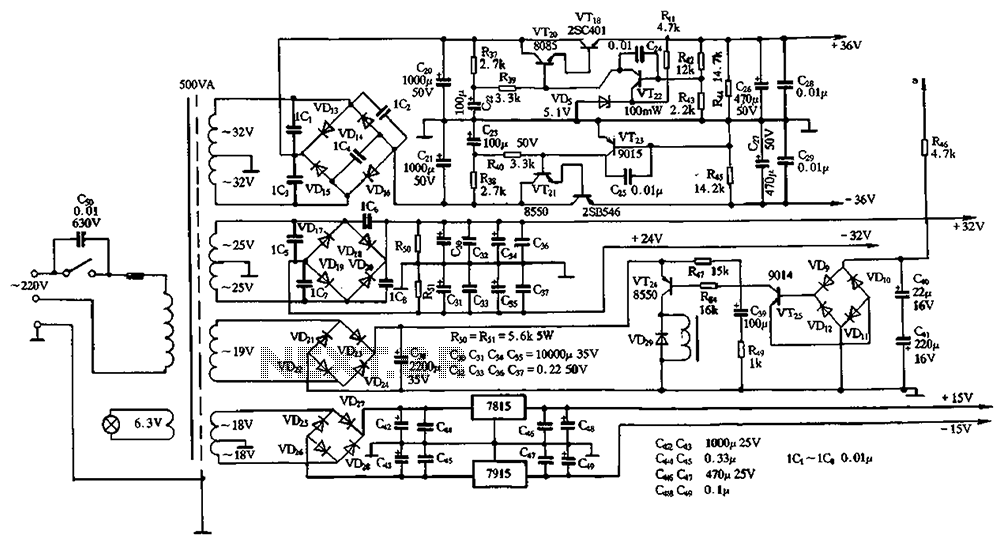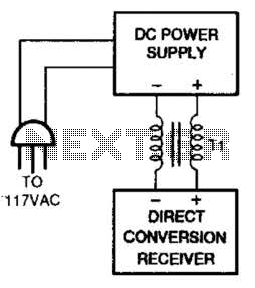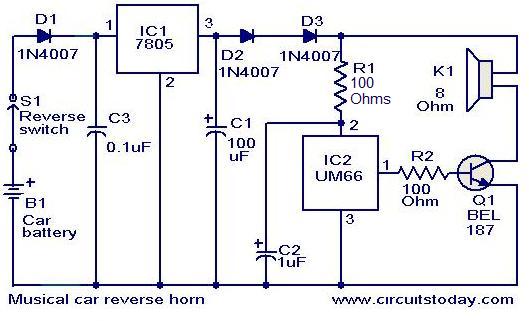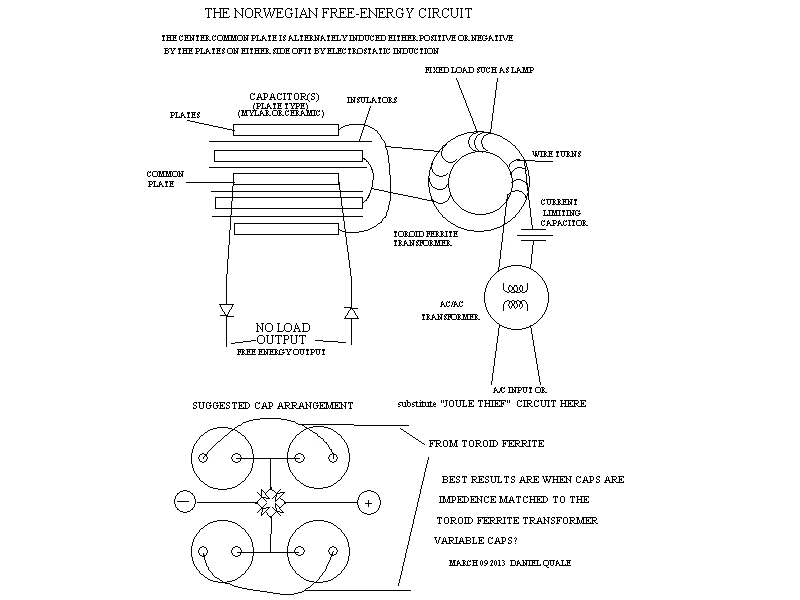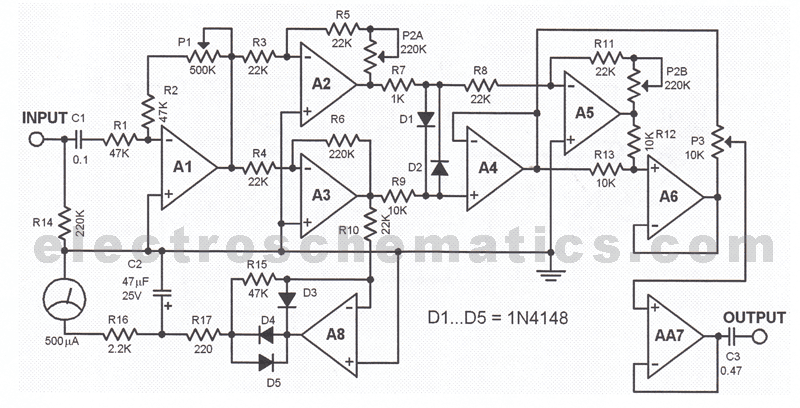
DOD Overdrive 250 preamp circuit diagram
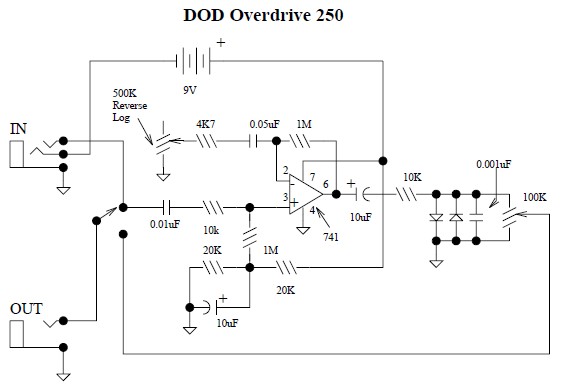
This document provides a circuit diagram for the DOD Overdrive 250 preamp. The DOD Overdrive 250 is similar to the MXR Distortion Plus and several other devices, utilizing a 741 operational amplifier with two diodes on the output channel. Additionally, it includes the circuit diagram for the DOD FX75 Flanger guitar effect pedal. The circuit, designed by Fabian P. Harter, incorporates various components including the CD4007 dual complementary pair with inverter, TL022C low power dual operational amplifier from Texas Instruments, MN3007 audio signal delay (a 1024-stage low noise bucket brigade device with delays ranging from 5.12 to 51.2 milliseconds), and the MN3101 clock generator for the bucket brigade device. Furthermore, a discrete JFET preamp design is highlighted, which employs the 2N5457 as the main component. This design is characterized by low noise, low distortion, low feedback, and graceful overload handling, providing an overall gain of approximately 3 dB (2X). Lastly, a simple, cost-effective vacuum tube preamp circuit designed by PAiA Electronics is mentioned, detailing the connections for various components including the 4049 CMOS Hex Inverting Buffer and the 5532 Dual Low-Noise operational amplifiers.
The DOD Overdrive 250 preamp circuit is a notable example of classic guitar effect design, leveraging widely recognized components to achieve a distinct sound profile. The circuit’s use of the 741 operational amplifier establishes a solid foundation for signal amplification, while the inclusion of two diodes at the output stage introduces clipping characteristics that enhance the overdrive effect. This configuration is designed to produce a warm, saturated tone that appeals to guitarists seeking a vintage sound.
The DOD FX75 Flanger circuit, as drawn by Fabian P. Harter, integrates advanced components such as the CD4007 and TL022C, which are essential for achieving the desired modulation effects. The CD4007 serves as a dual complementary pair, facilitating signal inversion and shaping, while the TL022C provides low power consumption and low noise amplification, critical for maintaining audio fidelity in guitar effects.
The MN3007 and MN3101 components are integral to the flanger's operation, allowing for precise delay manipulation and timing control. The MN3007’s bucket brigade architecture enables a range of delay times, contributing to the flanger’s sweeping sound effects.
The discrete JFET preamp design utilizing the 2N5457 transistor is particularly noteworthy for its low noise and distortion properties, making it suitable for high-fidelity applications. This design approach is favored by those who prefer a more analog and less op-amp-centric architecture, providing a unique tonal character and responsiveness.
The PAiA Electronics vacuum tube preamp circuit represents a classic approach to amplification, utilizing the inherent qualities of vacuum tubes to deliver warmth and depth to the audio signal. The circuit configuration, which includes the 4049 CMOS Hex Inverting Buffer and 5532 Dual Low-Noise operational amplifiers, is designed for ease of use and cost-effectiveness, making it accessible for hobbyists and professionals alike.
In summary, these circuits exemplify a blend of traditional and modern design philosophies in guitar effects, showcasing a range of components and configurations that cater to diverse sonic preferences. Each circuit serves a unique purpose, contributing to the rich landscape of guitar amplification and effects processing.This is the DOD Overdrive 250 preamp circuit diagram. The DOD Overdrive 250 is Yet Another 741 With Two Diodes On The Output channel. It is almost exactly the same as the MXR Distortion Plus, and a number of other units. Download the DOD Overdrive 250 circuit in PDF file: » Download Link This is the circuit diagram of DOD FX75 Flanger guitar effe ct pedal. The circuit drawn by Fabian P. Hartery Components CD4007 dual complementary pair with inverter; (RCA) TL022C low power dual operating amplifier; (texas instruments) MN3007 audio signal delay, 1024 stage low noise BBD (5. 12-51. 2 msec delay) MN3101 clock generator for Bucket Brigade Device/BBD. Designed by Don Tillman, this guitar pre-amp circuit design is dedicated for people who don`t like op-amps.
This circuit is a discrete JFET pre-amp design, use 2N5457 as the main component. It has low noise, low distortion, low feedback, overloads gracefully, is small, etc. Overall gain is 3db (2X) or so. It uses about 1/2. This is a simple and low cost Tube Head Vacuum Tube pre-amp circuit designed bu PAiA electronics: Vcc - Pin 1 IC1 +12v - Pin 8 IC2, IC3, IC4 -12v - Pin 4 IC2, IC3, IC4 Ground - Pin 8 IC1 IC1 - 4049 CMOS Hex Inverting Buffer IC2, 3, 4 - 5532 Dual Low-Noise. 🔗 External reference
The DOD Overdrive 250 preamp circuit is a notable example of classic guitar effect design, leveraging widely recognized components to achieve a distinct sound profile. The circuit’s use of the 741 operational amplifier establishes a solid foundation for signal amplification, while the inclusion of two diodes at the output stage introduces clipping characteristics that enhance the overdrive effect. This configuration is designed to produce a warm, saturated tone that appeals to guitarists seeking a vintage sound.
The DOD FX75 Flanger circuit, as drawn by Fabian P. Harter, integrates advanced components such as the CD4007 and TL022C, which are essential for achieving the desired modulation effects. The CD4007 serves as a dual complementary pair, facilitating signal inversion and shaping, while the TL022C provides low power consumption and low noise amplification, critical for maintaining audio fidelity in guitar effects.
The MN3007 and MN3101 components are integral to the flanger's operation, allowing for precise delay manipulation and timing control. The MN3007’s bucket brigade architecture enables a range of delay times, contributing to the flanger’s sweeping sound effects.
The discrete JFET preamp design utilizing the 2N5457 transistor is particularly noteworthy for its low noise and distortion properties, making it suitable for high-fidelity applications. This design approach is favored by those who prefer a more analog and less op-amp-centric architecture, providing a unique tonal character and responsiveness.
The PAiA Electronics vacuum tube preamp circuit represents a classic approach to amplification, utilizing the inherent qualities of vacuum tubes to deliver warmth and depth to the audio signal. The circuit configuration, which includes the 4049 CMOS Hex Inverting Buffer and 5532 Dual Low-Noise operational amplifiers, is designed for ease of use and cost-effectiveness, making it accessible for hobbyists and professionals alike.
In summary, these circuits exemplify a blend of traditional and modern design philosophies in guitar effects, showcasing a range of components and configurations that cater to diverse sonic preferences. Each circuit serves a unique purpose, contributing to the rich landscape of guitar amplification and effects processing.This is the DOD Overdrive 250 preamp circuit diagram. The DOD Overdrive 250 is Yet Another 741 With Two Diodes On The Output channel. It is almost exactly the same as the MXR Distortion Plus, and a number of other units. Download the DOD Overdrive 250 circuit in PDF file: » Download Link This is the circuit diagram of DOD FX75 Flanger guitar effe ct pedal. The circuit drawn by Fabian P. Hartery Components CD4007 dual complementary pair with inverter; (RCA) TL022C low power dual operating amplifier; (texas instruments) MN3007 audio signal delay, 1024 stage low noise BBD (5. 12-51. 2 msec delay) MN3101 clock generator for Bucket Brigade Device/BBD. Designed by Don Tillman, this guitar pre-amp circuit design is dedicated for people who don`t like op-amps.
This circuit is a discrete JFET pre-amp design, use 2N5457 as the main component. It has low noise, low distortion, low feedback, overloads gracefully, is small, etc. Overall gain is 3db (2X) or so. It uses about 1/2. This is a simple and low cost Tube Head Vacuum Tube pre-amp circuit designed bu PAiA electronics: Vcc - Pin 1 IC1 +12v - Pin 8 IC2, IC3, IC4 -12v - Pin 4 IC2, IC3, IC4 Ground - Pin 8 IC1 IC1 - 4049 CMOS Hex Inverting Buffer IC2, 3, 4 - 5532 Dual Low-Noise. 🔗 External reference
